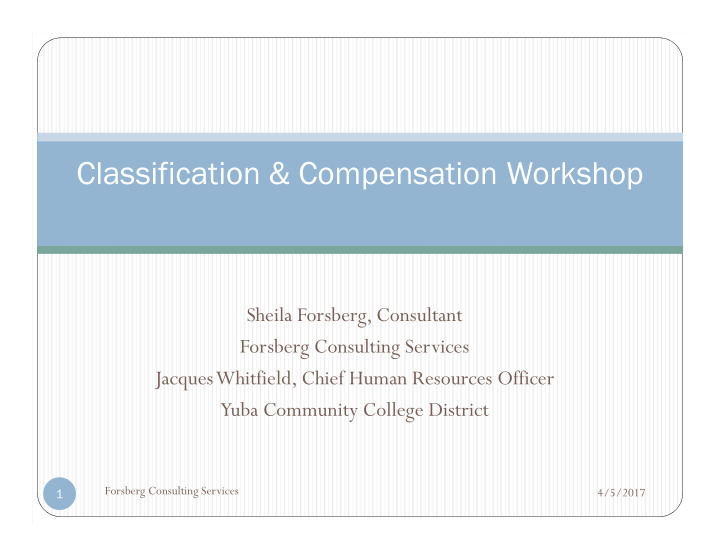



Classification & Compensation Workshop Sheila Forsberg, Consultant Forsberg Consulting Services Jacques Whitfield, Chief Human Resources Officer Yuba Community College District Forsberg Consulting Services 4/5/2017 1
Overview of Workshop � Classification and Compensation – Relationship � Define Classification – what is classification? � Understanding Classification – what it is and isn’t � Job Evaluation Methods � Job Evaluation Factors � Classification Process � Determining Compensation � Navigating the Hazards – Factors to Avoid Forsberg Consulting Services 4/5/2017 2
Relationship of Classification to Compensation � Classification � Defines the organizational structure � Basis for establishing a compensation program that is related to the nature and level of work performed � Means of ensuring internal equity � Provides current and accurate job descriptions – performance evaluation, recruitment tool � Compensation � Market competitiveness � Attract and retain well qualified personnel � Internal equity Forsberg Consulting Services 4/5/2017 3
What is Classification? � Process through which positions are assigned to a level within the organization � Based upon clear definitions and consistent use of class levels, class series, titling conventions, and levels of supervision � Basis for establishing defensible salary levels and ensuring internal equity � Must be understandable, defensible, and easily administered Forsberg Consulting Services 4/5/2017 4
Understanding Classification – what it is and isn’t � Positions are classified – not people � Recognizes a regular and ongoing assignment � Classification levels reflect material differences in scope, complexity, and responsibility � Business needs of the organizational unit � Not intended to recognize/reward knowledge or skills unrelated to assigned job � Not based on personal performance � Not based on longevity � Not based on an increase in volume of work Forsberg Consulting Services 4/5/2017 5
What are Job Evaluation Methods � Systematic approach to determining the relative worth or importance of each job in a classification plan � Quantitative – Point Factor, Factor Comparison � Pros – considered more objective; compares dissimilar jobs � Cons – difficult to learn, maintain, and administer; not easily understood; requires significant training � Non-Quantitative – Job Ranking, Whole Job � Pros – requires less time to learn and maintain; easily understood and communicated; flexible � Cons – considered less objective Forsberg Consulting Services 4/5/2017 6
Job Evaluation Factors � Expertise � Education and Training � Measures the knowledge, skill, and ability required to perform the job as acquired through education and training � Complexity � Measures the difficulty, increased discretion, resourcefulness, and technical effort required � Experience � Measures the years of directly related experience required for a candidate to be successful Forsberg Consulting Services 4/5/2017 7
Job Evaluation Factors – cont’d � Decision Making � Independence –Authority or “Freedom of Action” � Measures the amount of independence and latitude involved in the decision making process by evaluating the nature of the supervision that a particular class receives, e.g., direction, general direction, administrative direction, general administrative direction, policy direction � Impact of Decisions � Evaluates the freedom and authority to complete assignments that involve problem solving and decision making, and the consequences of associated decisions on the organizational unit and/or the organization as a whole – does not simply measure accuracy of completing assignments Forsberg Consulting Services 4/5/2017 8
Job Evaluation Factors – cont’d � Supervisory Responsibility � Nature of group supervised, e.g., unskilled/semi-skilled, paraprofessional/technical, professional, supervisory/management � Diversity of staff supervised, e.g. students, classified, adjunct, faculties, administrators � Direct supervision vs. technical/functional Forsberg Consulting Services 4/5/2017 9
Job Evaluation Factors – cont’d � Contacts � Type of Contacts � Identifies the types and levels of people within whom the employee most regularly has contact, e.g., general, customer, diverse, executive � Purpose of Contacts � Nature and purpose of the typical interactions required between the employee and others Forsberg Consulting Services 4/5/2017 10
Classification Process � Gather information – research, interviews � Analyze information � Using job analysis, analyze the essential duties of the job against each factor on a relative basis � Compare to other classifications within same or related job family � Horizontal and vertical � Determine appropriate compensation Forsberg Consulting Services 4/5/2017 11
Determining Compensation � External Market � Determine labor market � Conduct survey – comparability � Evaluate relationship based on labor market position (policy) – mean, median, other � Internal Equity � Analyze internal relationships using Job Evaluation Factors � Place salary using horizontal and vertical internal relationships Forsberg Consulting Services 4/5/2017 12
Navigating the Hazards – Factors to Avoid � Volume of Work � Central Tendency/Leniency and Severity � Individual Qualifications � Performance – Halo Effect (positive or negative) � Longevity � Organizational Issues � Future assignments � Potential changes � Market Conditions/Recruitment Issues Forsberg Consulting Services 4/5/2017 13
Recommend
More recommend